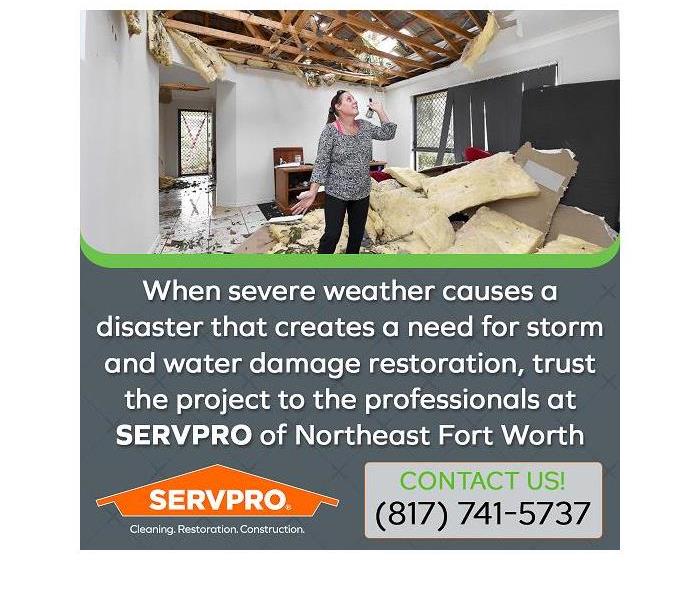Technology: A Life-Saving Tool for Helping Communities Prepare for Storms and Storm Damage
5/12/2022 (Permalink)
Blog Summary: The team at SERVPRO of Northeast Fort Worth understands the devastation storms can bring. When storms are in the forecast, home and business owners can use technology as a tool to help prepare for severe weather.
When storm and flood restoration services are needed as a result of severe weather, trust SERVPRO of Northeast Fort Worth, a locally owned and operated damage restoration company. Technicians provide residential and commercial property damage cleanup services to Fort Worth, Keller, and Park Glen areas with continuous coverage twenty-four hours a day, seven days a week. The team is dedicated to customer service.
The thunderous roar of an approaching tornado is traumatic for anyone caught in its path. The massive scale of the event leaves people helpless. Technology levels the playing field, giving people the tools to weather the storm without injury.
Tech experts cast the future of weather technology in a positive light, writing, “Natural disasters still kill around 10,000 people a year, but that number has fallen substantially over the years. As the world’s resources have advanced, people have become better equipped to handle these events. If technology continues on its current path, it will reduce these numbers even further.”
How modern technology is improving the odds for people to make it through the storms safe and sound.
1. Modeling the storm season to anticipate severe weather
Accurate expectations of future weather events improve response and survival strategies. Storm type, timing, and intensity are crucial to creating and executing the best response. Modeling is a source of this vital life-saving data.
Powerful supercomputers analyze weather satellite data to simulate seasonal hurricane activity. These powerful systems generate reliable predictions concerning storm sizes, times, and behaviors. Agencies are empowered to respond appropriately. The adoption of artificial intelligence (AI) refines these predictions. AI is the future of hurricane season prediction because hurricanes are so unpredictable.
2. Rapid alert systems
Modern communications technology enables meteorologists to alert agencies and the general population with an efficiency and speed never before experienced. Preparedness involves both modeling and fast-flowing lines of communication. Fast, clear alerts give agencies, institutions, businesses, and individuals critical time needed to be ready for the extreme weather.
Smartphone technology is vastly superior to older technologies such as strategically located sirens. The portability of digital alerts through cell phone technology means almost everyone with a cell phone receives a real-time alert. Wireless emergency alerts, WEA, save lives.
3. Tornado tracking technology
Occurring at a rate of about 1,200 per year in the US, tornadoes are frequent, violent, and difficult to predict. Advances in technology mean that scientists are better equipped to track the rambunctious twisters.
Accurate tracking results in accurate alerts that help people respond, take cover, and survive the storm. This acute awareness of a tornado’s location also allows rescue agencies to quickly deploy emergency teams to devastated areas. By shaving minutes off response times, first responders can save lives in the wake of storms.
4. Reinforced infrastructure
Sheltering in place is potentially dangerous if the shelter is not compliant with modern building codes. Stronger building materials and techniques reduce damage. Basements and storm shelters provide a safe refuge for people who have had to evacuate their homes or businesses. Hurricane windows and doors can sustain high-speed, high-impact collisions with flying debris. Reinforced garage doors are amazingly resilient under extreme conditions. A garage-door failure could also lead to a catastrophic roof failure.
5. Smart power grids
The cold weather disaster of February 16, 2021, demonstrated the vulnerability of the North Texas power grid. A failed power grid puts the general population at risk while, at the same time, hindering a coordinated response effort.
Monitors and sensors in the smart grid feed power companies needed data. Customers in the offline grid receive alerts of the outage and estimates of when the power will be restored. Some tech equipment has the sophistication to troubleshoot problems. Utility companies respond to these informative alerts and restore power much more quickly than in past decades.
6. New tools for understanding weather events
Accurate, timely information saves lives. Real-time weather conditions are constantly monitored at over 900 surface observation stations across the United States. This granulated information helps scientists more fully understand the nature of “Mother Nature” when dealing with the causes and behavior of extreme weather.
Why Storm Damage Restoration Services From SERVPRO
Modern technology saves lives, but it does not necessarily prevent storm damage. When severe weather causes a disaster that creates a need for storm and water damage restoration, trust the project to the professionals at SERVPRO of Northeast Fort Worth, Texas. Technicians are experienced, certified, and well-equipped to tackle any size disaster.
When home or business owners need storm damage restoration services, they can call the SERVPRO of Northeast Fort Worth office at (817) 900-0580 for emergency restoration services. The team can also be contacted by email at office@SERVPROnortheastftworth.com





 24/7 Emergency Service
24/7 Emergency Service
